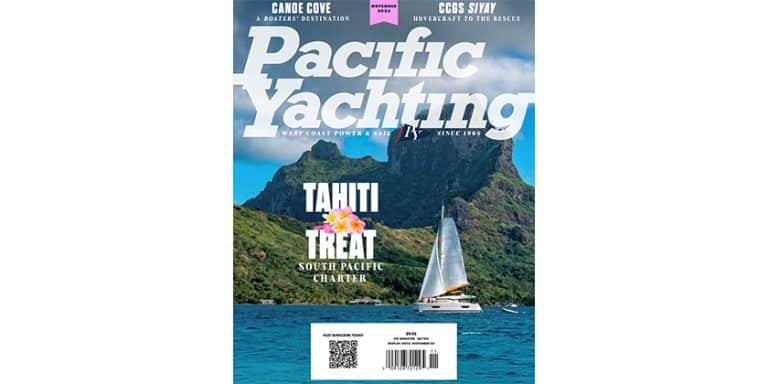Cowichan Bay—A Slow-Living Escape to Marine Heritage, Food and Local Artisanry
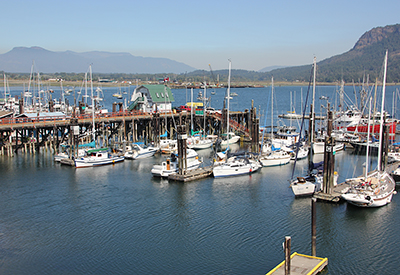
Text and Photos by Marianne Scott
Cowichan Bay is a waterfront village with a row of shops, artisan products, marine supplies and a variety of places to eat. It also has a delightful Maritime Centre. You can easily spend a day or more here at one of three marinas hosting transient moorage. The place feels like an old-fashioned fishing village.
We arrived at this quaint hamlet on a calm day when the sun burned off twists of mist and created undulating oval diamonds on the wavelets. From the water, the village looks enticing with its dense jumble of colourful character buildings, float homes and houses-on-stilts lining the coast.
Cowichan Bay was home to the Coast Salish people for millennia. They harvested salmon and shellfish found in the local coves, tidal flats and the Cowichan River. The name Cowichan (it’s had many other spellings) is derived from the Halkomelem term, “shkewétsen,” or “Quw’utsun,” which is explained as “basking in the sun,” and “warming the back,” a reference to the nearby rocky Mt. Tzouhalem where, tradition has it, the shape resembles a frog sunning itself. European settlers arrived here in the 1860s and established commercial logging and fishing industries. Today, tourism is the mainstay.
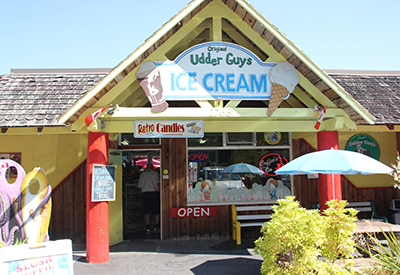
A special treat is ice cream from the Udder Guys
Located about halfway between Victoria and Nanaimo, on Vancouver Island’s east side, Cowichan Bay isn’t difficult to approach. Separation Point shelters the harbour somewhat, and whether you arrive from either the north or the south, you traverse Satellite Channel, bordering the west side of Salt Spring Island. Calculating the tides through this waterway will certainly help your speed as currents flow swiftly. Except for the marked Paley Rock and Musgrave Rock, there are no obstacles until you close in on your Cowichan Bay marina; there you must wend your way carefully among the horde of boats anchored in the Bay. There are a group of liveaboards here, as there are at many locations along the BC coast. Most of these residents occupy their vessels as an antidote to high real estate prices.
The Village of Cowichan Bay distinguishes itself from other small communities by being the first in Canada to have joined an Italian-founded movement called “Cittaslow.” Launched in Tuscany in 1999, its name means “slow city,” and was inspired by the slow food movement, whose philosophy opposes standardized fast food.
Many local merchants became members of Cowichan Bay Cittaslow. Its current president, Jane Kilthei, told me about the organization’s principles. “Goals include tempering a town’s overall pace, preserving its character, focusing on high-quality local food and drink, while countering ‘anywhere North America,’” she said. “We are very committed and plan to bring the concept to the wider Cowichan Valley as well.”
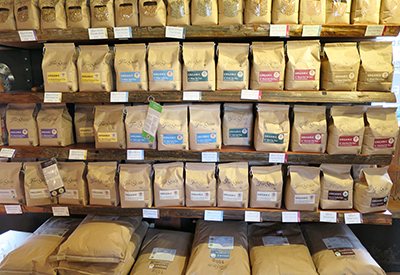 Cittaslow doesn’t mean that a town’s heritage is cast in concrete, but its philosophy seeks to prevent such franchises as McDonald’s or KFC from moving in and making the village look “homogenized,” while crowding out local establishments.
Cittaslow doesn’t mean that a town’s heritage is cast in concrete, but its philosophy seeks to prevent such franchises as McDonald’s or KFC from moving in and making the village look “homogenized,” while crowding out local establishments.
You can bake your own bread by buying True Grain’s Flours
The Cowichan area (which includes the Cowichan Valley with its emphasis on local, organic agriculture and wineries) has adopted the slogan, “Slow Down, Savour Life.” The seaside village’s culture certainly follows these ideas with its focus on local and handmade goods—all taking extensive time to prepare.
We couldn’t resist having dessert first at the Original Udder Guys Ice Cream dispensary. My husband, David, indulged in maple walnut and I enjoyed orange ice cream with chocolate bits. We caught owner Yves Muselle in the middle of producing several batches of ice cream. He told us that his basic ice cream recipe includes only four ingredients: milk, sugar, cream and egg yolk. “Egg yolk,” he said, “serves as a stabilizer. I don’t add gums or other emulsifiers. I hand-make the ice cream from scratch without artificial additives. I’ve made at least 102 flavours and make special orders for restaurants and weddings. Like lemon-lavender. Liqueur-based ice cream for Christmas. And so on.” In a normal, pre-Covid summer, Udder Guys sell about 500 cones a day.
Down the block, we found True Grain, a bakery whose scents of freshly baked bread tug you through the front door. The bakery prepares handcrafted bread using organic grains without added sugar, oils or preservatives. The bakery first opened in 2004 and it’s the epitome of local: their grains are grown in BC and they shun GMOs. They stone-grind their grains and bake fresh loaves daily – unsold baked goods are donated to food banks. Among other specialties, you can buy loaves of wholegrain spelt, cinnamon raisin, red-fife sourdough and whole-grain Khorasan. Other grains include Einkorn and Emmer – both old wild types of grasses originating in the Middle East and edible by gluten-sensitive people. Pastries and cookies also entice. The motto of owner Bruce Stewart, quoting Saint-Exupéry, is, “We have learned to see in bread an instrument of community among men – the flavour of bread shared has no equal.”
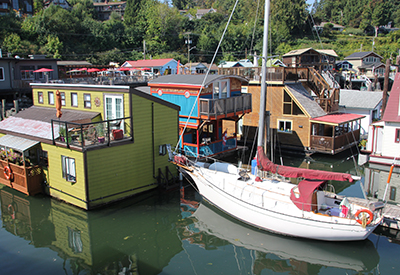 One of the town’s most popular restaurants, the Rock Cod Café, closed due, they say, to the decline of patronage during the pandemic. While I was there, rumours were floating that a new owner will appear, so keep your eyes open. We could only have sampled all the other food dispensaries if we’d stayed in Cowichan Bay a week—places like the Cow Café with its excellent view of the harbour, Rob’s Lighthouse where you can rub elbows with locals, the halibut tacos or roast beef yorkies at the Cowichan Bay Pub, SaThian Thai, The Vines’ famous sweet and savoury crepes, or the fine dining at the Masthead in the former Columbia Hotel, dating back to 1863. That building has a storied history: among other trades, it served as an inn and restaurant when travellers and traders followed the rutted wagon trail north. In the 1800s, the 60-kilometre trip from Victoria took days instead of today’s hour-long drive.
One of the town’s most popular restaurants, the Rock Cod Café, closed due, they say, to the decline of patronage during the pandemic. While I was there, rumours were floating that a new owner will appear, so keep your eyes open. We could only have sampled all the other food dispensaries if we’d stayed in Cowichan Bay a week—places like the Cow Café with its excellent view of the harbour, Rob’s Lighthouse where you can rub elbows with locals, the halibut tacos or roast beef yorkies at the Cowichan Bay Pub, SaThian Thai, The Vines’ famous sweet and savoury crepes, or the fine dining at the Masthead in the former Columbia Hotel, dating back to 1863. That building has a storied history: among other trades, it served as an inn and restaurant when travellers and traders followed the rutted wagon trail north. In the 1800s, the 60-kilometre trip from Victoria took days instead of today’s hour-long drive.
Cowichan Bay is home to Float homes and homes on stilts
If you need any marine supplies, the Classic Marine chandlery carries what you need and is located right in the middle of the strip—they’ve added a room with gently used marine supplies. Handmade is on display at the Mud Room Clayworks, where Colleen Underwood makes functional pottery, thereby marrying utility and art. Her mugs, bowls, platters, vases and cheerful teapots are useful and imaginative. The entry to her shop, enlivened by a horde of plants, is down the alley from True Grain. Beachology allows you to bring decorative items and clothing inspired by the beach to your home, while the Pirate Shop next-door displayed brightly painted fishes and sea creatures on a bench outside. In keeping with the village’s trends, Radway’s Fair Trade & Eco Fashion offers upcycled, handmade and organic clothing and accessories.
For groceries, Pier 66 not only offers the basics, but I spied jars of pesto and other delicacies on the shelves. The store also sells beer, wine and spirits, and serves as a post office.
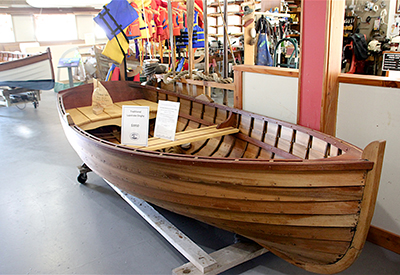 A few paces further down the coastal row of shops, I met Laurie Arbuthnot, who creates her artisan fragrances like an alchemist in a cave—although her shop, Wild Coast Perfumery, is filled with light and scores of essence-filled bottles. “My Vancouver Island location is my inspiration,” she told me. “Memories of scent influence my plant-based perfumes. I harvest wild plants and use essential oil tinctures to create my botanical perfumes and colognes.”
A few paces further down the coastal row of shops, I met Laurie Arbuthnot, who creates her artisan fragrances like an alchemist in a cave—although her shop, Wild Coast Perfumery, is filled with light and scores of essence-filled bottles. “My Vancouver Island location is my inspiration,” she told me. “Memories of scent influence my plant-based perfumes. I harvest wild plants and use essential oil tinctures to create my botanical perfumes and colognes.”
a sample lapstrake dinghy at the Cowichan Bay Maritime centre
The Cowichan Bay Spa and Salon can soothe any sore muscles you might have experienced aboard, as well as many cosmetic procedures and acupuncture.
Half a block further, we visited one of our treasured artists, Arthur Vickers. He and his wife, Jessica, welcomed us warmly in the spacious gallery. Arthur’s work reveals his First Nation’s roots and inspiration, but with a contemporary interpretation of his heritage. We’d always admired his carvings, serigraphs and paintings, but recently, Arthur has focused on his invention of handcrafted, multi-layered, low-relief sculpting in 24k-gold-leaf on a black background. It’s luminous and gorgeous. Community-minded, he sometimes teaches kids art at the Maritime Centre.
The Cowichan Maritime Centre is one of our favourite venues. They employ only three paid staff, but are aided by a flock of dedicated volunteers, mostly bearded, retired gentlemen. In the museum’s main building, excellent models of such iconic ships as Columbus’ Santa María and Frances Drake’s Golden Hind are displayed. I peered at one replica, the frigate Berlin, whose protruding brass cannons were so realistic, it seemed they could blast out a cannonball.
Until recently, the Centre’s other displays extended along a pier, showing vintage outboards, historic photos, fallers’ tools, and a kid station where they can hammer out a wood project. The pier culminated in a “Supercargo Pavillion” featuring 11 colourful and precise carvings of traditional fish boats by the late T’sou-ke band member Harvey George. These fish boat styles no longer ply our waters, but their precise and built-to-scale models offer a remarkable introduction to a once abundant profession and resource on our coast.
Unfortunately, the pier is closed—its pilings have been weakened by decades of saltwater, wind and critter attacks. A major fundraising effort is underway to replace the pilings. This summer, some of Harvey’s fish boat models will be on display in the Centre’s main building.
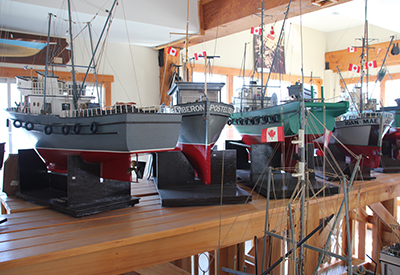 Throughout the year, the Maritime Centre offers boatbuilding training. Woodworking for teens and women is popular. Each year, the Centre builds an Iain Oughtred-designed 10.6-foot Acorn, a clench-nail, lapstrake traditional rowing skiff. Students come from around the world to learn these traditional wooden-boat building methods. The Acorn rowboat they construct is raffled off to support the Society.
Throughout the year, the Maritime Centre offers boatbuilding training. Woodworking for teens and women is popular. Each year, the Centre builds an Iain Oughtred-designed 10.6-foot Acorn, a clench-nail, lapstrake traditional rowing skiff. Students come from around the world to learn these traditional wooden-boat building methods. The Acorn rowboat they construct is raffled off to support the Society.
A few of Harvey George’s fish boat models
Like other small museums, the Maritime Centre must be creative to survive financially. It raises funds in many ways—a boat donation program, the Acorn raffle and an annual garage sale. Sometimes people bring in older vessels and staff and volunteers refurbish them for sale. Seminars and workshops focus on woodworking, with one popular course concentrating on sharpening your woodworking tools.
If you have children aboard, they may be able to participate in some of the Centre’s programs. Every year, volunteer George Karras collects two-by-six pieces of wood donated by Western Forest Products and Pacific Truss. “Each of about 3,500 kids come and create their own small sailboat,” George said proudly.
The Cowichan Bay seaside village is one of east Vancouver Island’s most delightful stop-overs. People are friendly and say hello on the walkways. Artisan edibles and other products are everywhere. You can ramble among the shops and restaurants and amble along the docks. It’s a great place to relax at a Cittaslow pace.
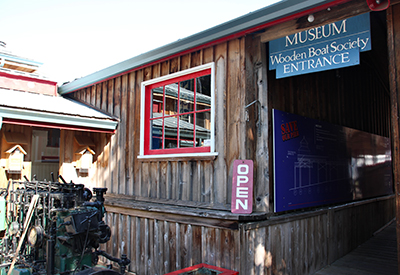
Entrance to the Maritime Centre with a vintage Atlas engine displayed outside.
If You Go
These marinas in Cowichan Bay offer transient moorage. All three provide direct access to the village stores and restaurants.
Dungeness Marina. Transient moorage is available for vessels up to 80’. Showers; 30 amp & water; laundry at Pier 66; wireless internet. Phone 250-748-6789 (no VHF) or email info@dungenessmarina.com for reservations and arrival.
Bluenose Marina, Transient moorage available but check for availability. 30-50 amp power; no VHF. Showers & laundry. Phone 250-748-2222 or email info@TheBluenoseMarina.com for reservations and arrival.
Cowichan Bay Fishermen’s Wharf. Open all year, 900 feet of dock space for yachts to 100 feet, 30-amp power, free Wi-Fi, washrooms, laundry, showers, free pump-out. PLEASE NOTE: Docks at Fishermen’s wharf are behind a floating breakwater and aren’t connected to land. A dinghy is needed for shore access. No reservations. VHF 66A, phone 250-746-5911 or email CBFWA@shaw.ca the day of arrival.





